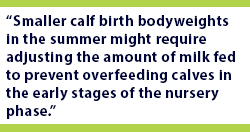
8 action items to reduce summer calf stressors
 By Dr. Noah Litherland, dairy technical services specialist
By Dr. Noah Litherland, dairy technical services specialistHeat stress can have significant impacts on dairy calf health and growth. Following are eight action items to reduce the negative impacts of summer heat.
1. Maternal effect
Data from controlled experiments suggest that cooling dry cows has a carryover effect on subsequent lactation performance as well as increased IgG absorption by calves and increased calf performance in the nursery phase.
- Action item: Provide fans and shade for both far-off and close-up dry cows.
 2. Calf bodyweight
2. Calf bodyweight
Gestation length (days carrying calf) tends to be shorter for cows calving in the summer months, resulting in lower calf birth bodyweight. That’s why average calf birth bodyweight tends to be lowest during July, August and September. An average birth bodyweight for Holstein heifers before the colostrum feeding ranges from 82 to 86 pounds. Smaller calf birth bodyweights in the summer might require adjusting the amount of milk fed to prevent overfeeding calves in the early stages of the nursery phase.
- Action item: Weigh and record calf birth bodyweight to look for trends. Tracking birth bodyweight will help with evaluating milk feeding amounts as well as provide important data for accurately calculating calf average daily gain.
3. Pathogens
Compared with winter, summer pathogen load and transmission are likely elevated due to increased rate of bacterial growth as well as bacteria transfer on humidity-laden air. We know that drying (desiccation) is an important step in the cleaning process, which is delayed or incomplete with high humidity.
- Action item: Step up efforts to sanitize feeding and calf-handling equipment using detergents and sanitizers at the appropriate concentration. Double-check that the water temperature matches the effective temperature of the detergent.
4. Colostrum and milk hygiene and cooling
Cooling colostrum and milk is an important quality control step in post-harvest handling. Milk that starts to ferment will undergo chemical changes, including a decrease in pH and an increase in osmolality due to bacterial activity. Starting with clean colostrum and clean milk, followed by timely and effective cooling, is a hallmark of maintaining milk quality for nursery calves.
- Action item: Use a thermometer to measure colostrum and milk temperature. Milk stored for greater than 12 hours should be cooled to 40 to 42 degrees F. If colostrum is not going to be used within 12 hours, freezing is better than refrigerating. Use a log sheet to record milk temperature at critical control points every week.
5. Bedding
Bedding calves in summer has its challenges. Calves benefit from a soft lying surface and the moisture-wicking properties of straw or shavings. Sand can be used as an inorganic bedding alternative for calves in the summer. Straw inventory on some farms might be running short by mid-summer, so having an alternative bedding source is helpful as long as the bedding is moisture-absorbent and does not cause irritation to the upper respiratory tract (as sawdust or fine-particle shavings may do). Bedding packs may need to be cleaned out more frequently in the summer.
- Action item: Evaluate calf hygiene with your current bedding system. Are calf knees, thighs, and hocks clean and dry? Evaluate the particle size of your bedding. Does the bedding process result in an excessive amount of dust in the calf’s environment?
6. Air quality
Greater bacteria activity in the summer results in greater production of fermentation gasses, such as ammonia, methane and hydrogen sulfide. These gasses can irritate the upper respiratory tract when present at high enough concentrations.
- Action item: Measure air ammonia concentration. Air ammonia greater than 10 ppm indicates a shift in management (increase bedding, change bedding, increase air exchange rate) is warranted.
7. Starter intake and rumen development
Calf size, health and rate of growth – in addition to starter quality and availability – all impact starter grain intake. Early starter grain intake kickstarts rumen development and increasing amounts of starter grain intake drives further rumen maturation (rumen papillae density and length, rumen volume, rumen wall muscle, rumen microbial population size and activity).
Starter intake tends to be lower during the summer. Environmental temperatures are closer to thermoneutral in the summer, so the drive to eat starter between milk meals is lower. As a result, calves tend to be older when they start consuming starter and, subsequently, tend to have lower peak starter grain intake and lower rumen development. This has carryover effects in the transition and grower stages as calves with lower starter intake tend to be smaller and grow more slowly than calves that eat appreciable amounts of starter during the nursery phase.
Starter quality is important to starter grain intake. Keep starter grain fresh by changing out starter at least twice weekly. Encourage early starter grain intake by hand-feeding a small amount of grain to calves at a week of age if they are not already eating starter.
- Action item: Increase days in the nursery phase after weaning to allow starter grain intake to build up to at least 5 pounds per day before transitioning calves to the grower phase. Keep bagged starter inventory freshly rotated in at least monthly intervals and store in a dry, well-ventilated area out of direct sunlight. Bulk bin inventory should be rotated every month in the summer. Check that bins do not have areas of feed accumulation on the inside and completely empty bins quarterly so the inventory is starting fresh.
8. Water intake
Water intake increases significantly in the summer. Increasing amount of water dispensed to calves at morning and evening feedings – and potentially offering a third water feeding during the day – is warranted during heat stress.
- Action item: Replace water filters as needed. Water filters should be replaced more frequently in the summer due to greater water volume use. Biofilms can develop in water hoses over time. Replace water hoses annually with drinking water-safe hoses. In-line water filters for hoses can be found in the RV section of farm and ranch supply stores, and can be helpful in reducing sediment and some minerals.
| Category: |
Animal handling Animal health Bedding Calf and heifer nutrition Colostrum management Employee management Starting Strong - Calf Care |

